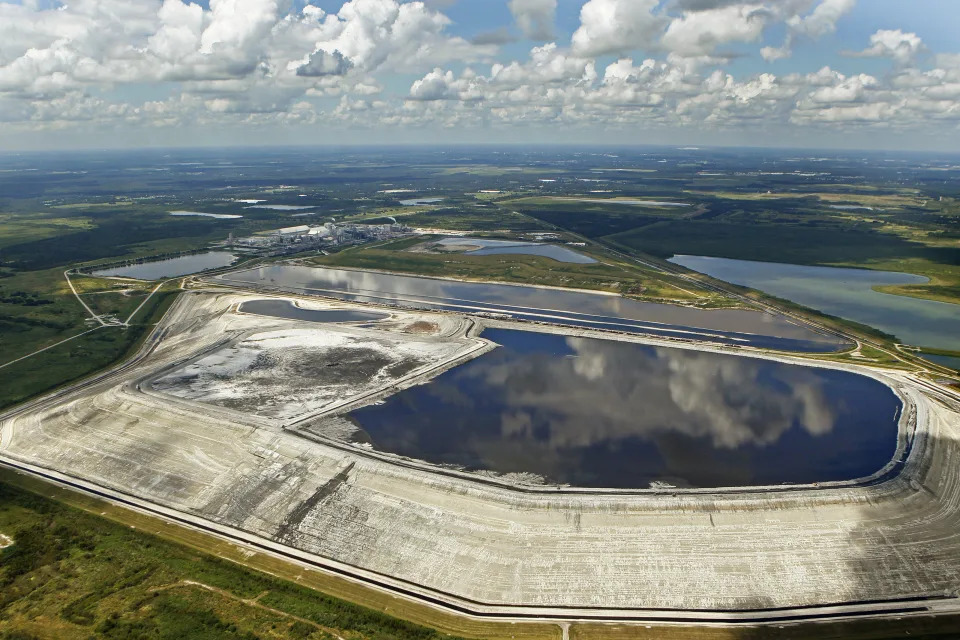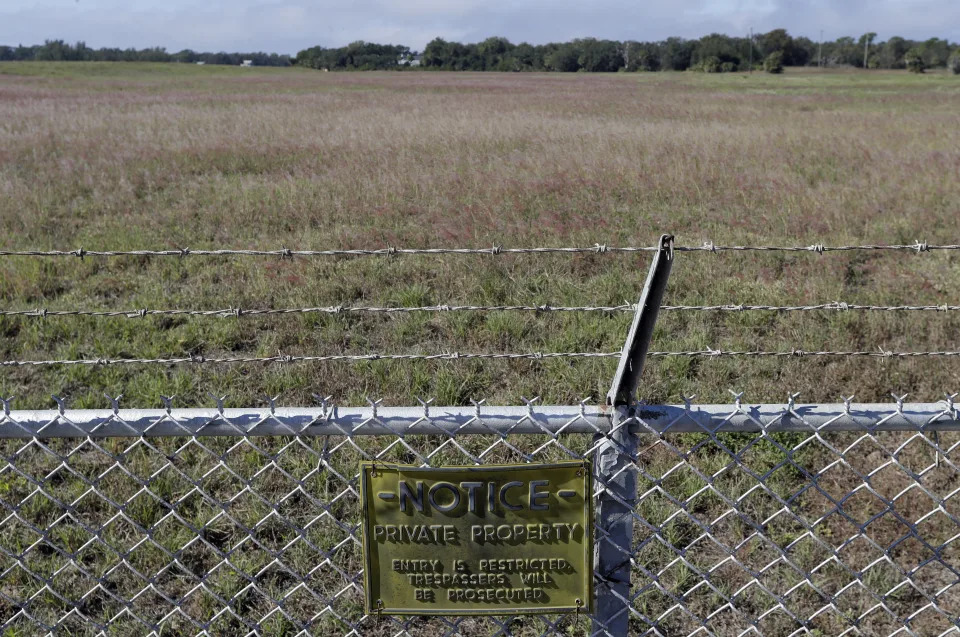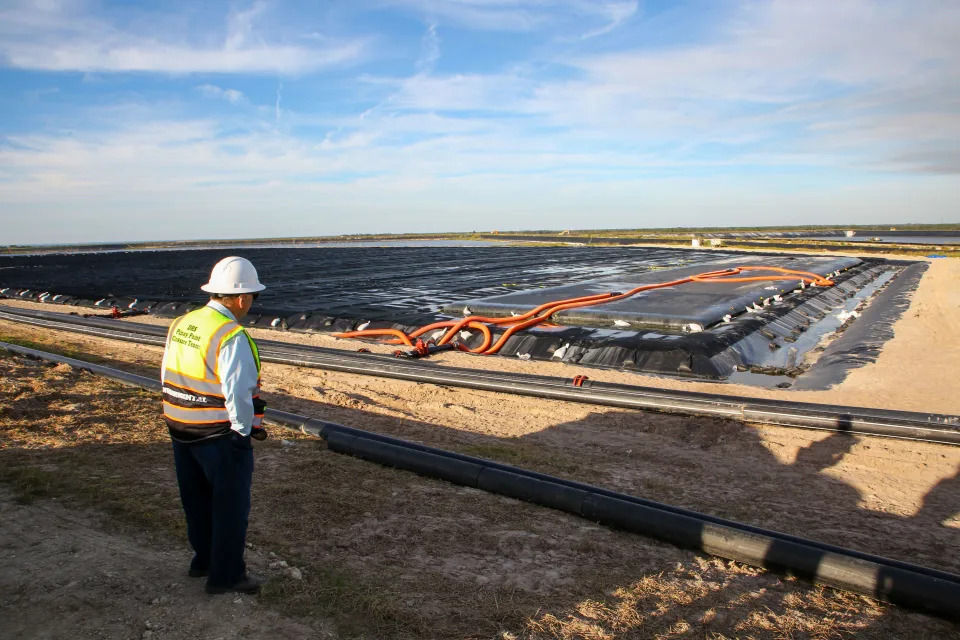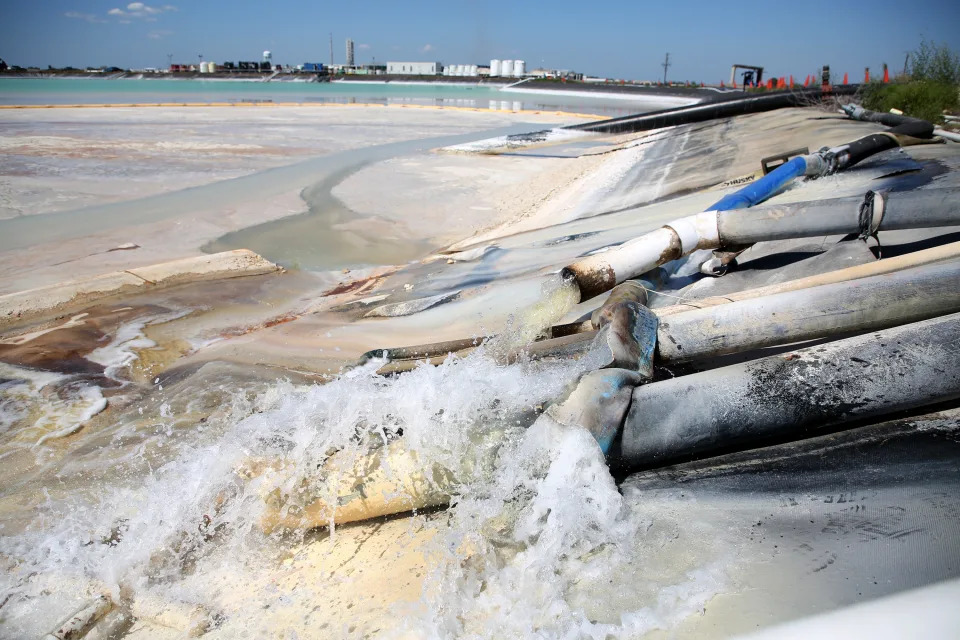Polluted waste from Florida's fertilizer industry is in the path of Milton's fury
MICHAEL BIESECKER and JASON DEAREN
Updated Wed, October 9, 2024


Hurricane Milton-Environmental Hazards
A sinkhole that opened up underneath a gypsum stack at a Mosaic phosphate fertilizer plant is seen in Mulberry, Fla., on Sept. 16, 2016.
MICHAEL BIESECKER and JASON DEAREN
Updated Wed, October 9, 2024


Hurricane Milton-Environmental Hazards
A sinkhole that opened up underneath a gypsum stack at a Mosaic phosphate fertilizer plant is seen in Mulberry, Fla., on Sept. 16, 2016.
(Jim Damaske/Tampa Bay Times via AP, File)
As Hurricane Milton pummeled Florida’s west coast with powerful winds and flooding rain, environmentalists worry it could scatter the polluted leftovers of the state’s phosphate fertilizer mining industry and other hazardous waste across the peninsula and into vulnerable waterways.
More than 1 billion tons of slightly radioactive phosphogypsum waste is stored in “stacks” that resemble enormous ponds at risk for leaks during major storms. Florida has 25 such stacks, most concentrated around enormous phosphate mines and fertilizer processing plants in the central part of the state, and environmentalists say nearly all of them are in Milton’s projected path.
“Placing vulnerable sites so close on major waterways that are at risk of damage from storms is a recipe for disaster,” said Ragan Whitlock, a staff attorney at the environmental group Center for Biological Diversity. “These are ticking time bombs.”
Phosphogypsum, a solid waste byproduct from processing phosphate ore to make chemical fertilizer, contains radium, which decays to form radon gas. Both radium and radon are radioactive and can cause cancer. Phosphogypsum may also contain toxic heavy metals and other carcinogens, such as arsenic, cadmium, chromium, lead, mercury and nickel.
That waste is even more troublesome because there is no easy way to dispose of it, leaving it to pile up and become an ever-growing target for such storms as the monster Milton, which made landfall in central Florida late Wednesday as a Category 3 storm, with sustained winds of about 120 mph (193 kph), a towering storm surge and 18 inches (46 centimeters) of rain.
A lesser storm, Hurricane Frances, which hit the state’s eastern coast as a Category 2 and churned across central Florida in 2004, sent 65 million gallons of acidic wastewater from phosphogypsum stacks into nearby waterways, killing thousands of fish and other marine life.
Of particular concern from Milton is the Piney Point wastewater reservoir, which sits on the shore of Tampa Bay and has had structural issues that have caused regular leaks over the years.
A March 2021 leak resulted in the release of an estimated 215 million gallons of polluted water into the bay and caused massive fish kills. Another leak in August 2022 unleashed another 4.5 million gallons of wastewater. Compounding the problem is the bankruptcy filing of the site’s former owner, HRC Holdings, leaving it to be managed by a court-appointed receiver.
The nation's largest phosphate producer, The Mosaic Company, owns two stacks at its Riverview facility that sit on the shore of Tampa Bay, as well as several farther inland. In 2016 a sinkhole opened beneath the company’s New Wales Gypstack, sending millions of gallons of contaminated sludge into the state’s main drinking water aquifer. The company said tests showed there were no offsite impacts from the incident, but the site is at risk of further damage from a storm as powerful as Milton.
Asked about its preparations for the coming storm, Mosaic pointed to a statement on its website: “Preparations for hurricane season include reviewing lessons learned from the previous year, updating our preparedness and response plans ... and completing inspections to ensure all test pumps, generators and other equipment needed in the event of severe weather are onsite and in proper working order.”
Florida and North Carolina are responsible for mining 80% of the U.S. supply of phosphorous, which is important not only to agriculture but to munitions production.
“At this time we are preparing locally for the storm, both professionally and personally,” Mosaic spokesperson Ashleigh Gallant said. “If there are impacts, we will release those publicly after the storm.”
Beyond the mine stacks, the Tampa Bay area is also home to old toxic waste sites that are considered among the worst in the nation. A former pesticide production site, the Stauffer Chemical Co., has polluted the Anclote River, groundwater and soil. Today it is an EPA Superfund site undergoing years of cleanup.
The EPA posted on the website that it is “ensuring that this site is secured for potential impacts from Hurricane Milton.”
The Florida Department of Environmental Protection said Tuesday it is preparing all available resources critical to the facilities it regulates, as well as securing state parks and aquatic preserves to minimize storm effects.
___
Biesecker reported from Washington, Dearen from Los Angeles.
As Hurricane Milton pummeled Florida’s west coast with powerful winds and flooding rain, environmentalists worry it could scatter the polluted leftovers of the state’s phosphate fertilizer mining industry and other hazardous waste across the peninsula and into vulnerable waterways.
More than 1 billion tons of slightly radioactive phosphogypsum waste is stored in “stacks” that resemble enormous ponds at risk for leaks during major storms. Florida has 25 such stacks, most concentrated around enormous phosphate mines and fertilizer processing plants in the central part of the state, and environmentalists say nearly all of them are in Milton’s projected path.
“Placing vulnerable sites so close on major waterways that are at risk of damage from storms is a recipe for disaster,” said Ragan Whitlock, a staff attorney at the environmental group Center for Biological Diversity. “These are ticking time bombs.”
Phosphogypsum, a solid waste byproduct from processing phosphate ore to make chemical fertilizer, contains radium, which decays to form radon gas. Both radium and radon are radioactive and can cause cancer. Phosphogypsum may also contain toxic heavy metals and other carcinogens, such as arsenic, cadmium, chromium, lead, mercury and nickel.
That waste is even more troublesome because there is no easy way to dispose of it, leaving it to pile up and become an ever-growing target for such storms as the monster Milton, which made landfall in central Florida late Wednesday as a Category 3 storm, with sustained winds of about 120 mph (193 kph), a towering storm surge and 18 inches (46 centimeters) of rain.
A lesser storm, Hurricane Frances, which hit the state’s eastern coast as a Category 2 and churned across central Florida in 2004, sent 65 million gallons of acidic wastewater from phosphogypsum stacks into nearby waterways, killing thousands of fish and other marine life.
Of particular concern from Milton is the Piney Point wastewater reservoir, which sits on the shore of Tampa Bay and has had structural issues that have caused regular leaks over the years.
A March 2021 leak resulted in the release of an estimated 215 million gallons of polluted water into the bay and caused massive fish kills. Another leak in August 2022 unleashed another 4.5 million gallons of wastewater. Compounding the problem is the bankruptcy filing of the site’s former owner, HRC Holdings, leaving it to be managed by a court-appointed receiver.
The nation's largest phosphate producer, The Mosaic Company, owns two stacks at its Riverview facility that sit on the shore of Tampa Bay, as well as several farther inland. In 2016 a sinkhole opened beneath the company’s New Wales Gypstack, sending millions of gallons of contaminated sludge into the state’s main drinking water aquifer. The company said tests showed there were no offsite impacts from the incident, but the site is at risk of further damage from a storm as powerful as Milton.
Asked about its preparations for the coming storm, Mosaic pointed to a statement on its website: “Preparations for hurricane season include reviewing lessons learned from the previous year, updating our preparedness and response plans ... and completing inspections to ensure all test pumps, generators and other equipment needed in the event of severe weather are onsite and in proper working order.”
Florida and North Carolina are responsible for mining 80% of the U.S. supply of phosphorous, which is important not only to agriculture but to munitions production.
“At this time we are preparing locally for the storm, both professionally and personally,” Mosaic spokesperson Ashleigh Gallant said. “If there are impacts, we will release those publicly after the storm.”
Beyond the mine stacks, the Tampa Bay area is also home to old toxic waste sites that are considered among the worst in the nation. A former pesticide production site, the Stauffer Chemical Co., has polluted the Anclote River, groundwater and soil. Today it is an EPA Superfund site undergoing years of cleanup.
The EPA posted on the website that it is “ensuring that this site is secured for potential impacts from Hurricane Milton.”
The Florida Department of Environmental Protection said Tuesday it is preparing all available resources critical to the facilities it regulates, as well as securing state parks and aquatic preserves to minimize storm effects.
___
Biesecker reported from Washington, Dearen from Los Angeles.
Milton likely to hit Florida’s phosphate mining hub, worrying environmentalists
Max Chesnes, Tampa Bay Times
Updated Wed, October 9, 2024



Douglas R. Clifford/Tampa Bay Times/TNS
Environmental groups are worried about possible pollution impacts as Hurricane Milton is likely to pass directly over Bone Valley, the heart of Florida’s phosphate mining and production.
According to a Tampa Bay Times analysis, 22 of Florida’s 25 phosphate waste piles are located in Hurricane Milton’s projected path over Manatee, Hillsborough and Polk counties. That’s according to the latest National Hurricane Center forecast and state environmental regulatory data as of Wednesday morning.
Mosaic, a Fortune 500 phosphate mining company headquartered in Tampa, said that it is “preparing locally for the storm both professionally and personally” at the several plants it operates in the region.
The company oversees a plant on the northeastern shores of Tampa Bay, in Riverview, and another further inland in Mulberry, among others. Their mounds of regulated phosphate waste are hundreds of feet tall and contain phosphogypsum, a mildly radioactive byproduct of the phosphate manufacturing process. These stacks also contain ponds of polluted wastewater used to create fertilizer.
As of Wednesday morning, Tampa Bay was forecast to see up to 12 feet of storm surge and damaging winds from what could be a Category 4 storm at landfall.
“We are worried that a direct hit from a storm as powerful as Milton could be catastrophic,” said Ragan Whitlock, an attorney for the Center for Biological Diversity, a nonprofit that has sued to increase phosphogypsum regulations.
A spokesperson for Mosaic, Ashleigh Gallant, said if there are impacts to these phosphoygypsum stacks, or “gypstacks,” that the company would “release those publicly after the storm.”
Mosaic prepares for hurricanes by conducting drills, inspecting its plants and making sure its test pumps, generators and other equipment is onsite and working, according to a website outlining its operations. After the storm, Mosaic staff assess damage and offer support to employees who have been personally affected by severe weather. A spokesperson for the Florida Department of Environmental Protection did not immediately respond to a request for comment.
Still, environmental watchdogs remain concerned.
“There are several phosphogypsum stacks situated precariously close to Tampa Bay’s waters,” Whitlock said. “We hope these facilities emerge from the sustained 100+ mph winds expected for the area unscathed, but open-air ponds of hazardous waste with historic structural integrity problems create a well-founded concern.”
Earlier this year, Mosaic confirmed to state environmental regulators that there was a tear in the protective liner beneath its gypstack in Mulberry. In 2016, a sinkhole stretching 152 feet opened beneath the gypstack and resulted in 215 million gallons of contaminated water draining into the aquifer below.
Many living in the Tampa Bay area also remember 2021, when millions of gallons of tainted water were sent from the Piney Point phosphate plant in Manatee County into the bay as a precaution due to fears that a leak in a reservoir could trigger a massive flood, endangering nearby homes and businesses. Last month, a judge ruled against the plant’s former owner, HRK Holdings, and ordered the company to pay more than $800,000.
Now, as the state has ordered the plant’s permanent closure, crews were on site earlier this week making sure it was prepped ahead of Milton.
“We spent a good amount of time earlier this week getting ready,” said Herb Donica, a lawyer and the court-appointed overseer of the plant. Donica has required every contractor on the site to have a written hurricane plan, and the site closed ahead of Milton at noon Tuesday.
Donica’s main concern is for his team’s mobile office. While it’s battened down, any sustained damage to the office would be “an interruption that we don’t want to have.”
It’s not safe for anyone to be on site during the storm, Donica said, and Piney Point’s managers have evacuated ahead of the anticipated hurricane-force winds from Milton.
“We are the most prepared that we can be,” Donica said.
Times staff writer Shreya Vuttarulu contributed to this report.
Max Chesnes, Tampa Bay Times
Updated Wed, October 9, 2024



Douglas R. Clifford/Tampa Bay Times/TNS
Environmental groups are worried about possible pollution impacts as Hurricane Milton is likely to pass directly over Bone Valley, the heart of Florida’s phosphate mining and production.
According to a Tampa Bay Times analysis, 22 of Florida’s 25 phosphate waste piles are located in Hurricane Milton’s projected path over Manatee, Hillsborough and Polk counties. That’s according to the latest National Hurricane Center forecast and state environmental regulatory data as of Wednesday morning.
Mosaic, a Fortune 500 phosphate mining company headquartered in Tampa, said that it is “preparing locally for the storm both professionally and personally” at the several plants it operates in the region.
The company oversees a plant on the northeastern shores of Tampa Bay, in Riverview, and another further inland in Mulberry, among others. Their mounds of regulated phosphate waste are hundreds of feet tall and contain phosphogypsum, a mildly radioactive byproduct of the phosphate manufacturing process. These stacks also contain ponds of polluted wastewater used to create fertilizer.
As of Wednesday morning, Tampa Bay was forecast to see up to 12 feet of storm surge and damaging winds from what could be a Category 4 storm at landfall.
“We are worried that a direct hit from a storm as powerful as Milton could be catastrophic,” said Ragan Whitlock, an attorney for the Center for Biological Diversity, a nonprofit that has sued to increase phosphogypsum regulations.
A spokesperson for Mosaic, Ashleigh Gallant, said if there are impacts to these phosphoygypsum stacks, or “gypstacks,” that the company would “release those publicly after the storm.”
Mosaic prepares for hurricanes by conducting drills, inspecting its plants and making sure its test pumps, generators and other equipment is onsite and working, according to a website outlining its operations. After the storm, Mosaic staff assess damage and offer support to employees who have been personally affected by severe weather. A spokesperson for the Florida Department of Environmental Protection did not immediately respond to a request for comment.
Still, environmental watchdogs remain concerned.
“There are several phosphogypsum stacks situated precariously close to Tampa Bay’s waters,” Whitlock said. “We hope these facilities emerge from the sustained 100+ mph winds expected for the area unscathed, but open-air ponds of hazardous waste with historic structural integrity problems create a well-founded concern.”
Earlier this year, Mosaic confirmed to state environmental regulators that there was a tear in the protective liner beneath its gypstack in Mulberry. In 2016, a sinkhole stretching 152 feet opened beneath the gypstack and resulted in 215 million gallons of contaminated water draining into the aquifer below.
Many living in the Tampa Bay area also remember 2021, when millions of gallons of tainted water were sent from the Piney Point phosphate plant in Manatee County into the bay as a precaution due to fears that a leak in a reservoir could trigger a massive flood, endangering nearby homes and businesses. Last month, a judge ruled against the plant’s former owner, HRK Holdings, and ordered the company to pay more than $800,000.
Now, as the state has ordered the plant’s permanent closure, crews were on site earlier this week making sure it was prepped ahead of Milton.
“We spent a good amount of time earlier this week getting ready,” said Herb Donica, a lawyer and the court-appointed overseer of the plant. Donica has required every contractor on the site to have a written hurricane plan, and the site closed ahead of Milton at noon Tuesday.
Donica’s main concern is for his team’s mobile office. While it’s battened down, any sustained damage to the office would be “an interruption that we don’t want to have.”
It’s not safe for anyone to be on site during the storm, Donica said, and Piney Point’s managers have evacuated ahead of the anticipated hurricane-force winds from Milton.
“We are the most prepared that we can be,” Donica said.
Times staff writer Shreya Vuttarulu contributed to this report.
From the Farm: Hurricane Milton’s effects on Central IL ag
Stu Ellis
Stu Ellis
WCIA Champaign
Thu, October 10, 2024
CENTRAL ILLINOIS (WCIA) — Hurricane Milton is hundreds of miles away from Central Illinois, but some impacts of the storm will be felt here.
Phosphate is a crop nutrient often applied to Corn Belt fields, and most of it is mined between Tampa and Orlando. Josh Linville, Vice President of Fertilizer for StoneX, said the facilities in Central Florida produce millions of tons of phosphate annually.
They may have been built to withstand hurricanes, Linville said, but there may be some damage and a lack of workers, who will be focused on damage to their own homes.
“Probably the most unfortunate, the fact that we’re less than four weeks away from the start of fall season. The Midwest is going to start rolling very, very hard Nov. 1,” Linville said. “Frankly, inventories have been tight anyway, globally and here at home. So prices are high, inventories are tight, we still see demand being pretty substantial here this fall and now, we just have this one more thorn in the side of the marketplace.”
Growmark gets its phosphate from the Florida mines and its Vice President of Crop Nutrients, Kreg Ruhl, agreed with Linville about the employee considerations.
“Whenever that happens, you lose days of production and that’s always confusing for people when we talk about fertilizer because you never get those days back and you can never replace the capacity that was lost during those days,” Ruhl said. “So as we think about the phosphate complex, even if this storm passes in in two or three days, the effects will take weeks to rectify. And like I said, we’re right at the beginning of fall and we’re in critical need of the supply that’s coming out of there.”
This, Ruhl said, will “absolutely” delay phosphate barges coming up the Mississippi River and disrupt supply for local supplies and farmers.
“About two-thirds of the domestic production of phosphates happens in Florida, and this storm will impact almost all of that production,” Ruhl explained. “And what we see move into Illinois, up the river system, actually starts in Florida, comes across the Gulf of Mexico in a boat and then transfers onto barges that end up in Central Illinois, so it’s a direct impact to our farmers.
Farmers are already paying unusually high prices for fertilizer and this situation will exacerbate their financial stress. Ruhl is already seeing prices start to fluctuate not just because of peak demand, but because of Milton as well.
“We’ve seen them rise dramatically just over the course of the last couple of days as people have watched this news unfold,” Ruhl said.
Copyright 2024 Nexstar Media, Inc. All rights reserved. This material may not be published, broadcast, rewritten, or redistributed.
Thu, October 10, 2024
CENTRAL ILLINOIS (WCIA) — Hurricane Milton is hundreds of miles away from Central Illinois, but some impacts of the storm will be felt here.
Phosphate is a crop nutrient often applied to Corn Belt fields, and most of it is mined between Tampa and Orlando. Josh Linville, Vice President of Fertilizer for StoneX, said the facilities in Central Florida produce millions of tons of phosphate annually.
They may have been built to withstand hurricanes, Linville said, but there may be some damage and a lack of workers, who will be focused on damage to their own homes.
“Probably the most unfortunate, the fact that we’re less than four weeks away from the start of fall season. The Midwest is going to start rolling very, very hard Nov. 1,” Linville said. “Frankly, inventories have been tight anyway, globally and here at home. So prices are high, inventories are tight, we still see demand being pretty substantial here this fall and now, we just have this one more thorn in the side of the marketplace.”
Growmark gets its phosphate from the Florida mines and its Vice President of Crop Nutrients, Kreg Ruhl, agreed with Linville about the employee considerations.
“Whenever that happens, you lose days of production and that’s always confusing for people when we talk about fertilizer because you never get those days back and you can never replace the capacity that was lost during those days,” Ruhl said. “So as we think about the phosphate complex, even if this storm passes in in two or three days, the effects will take weeks to rectify. And like I said, we’re right at the beginning of fall and we’re in critical need of the supply that’s coming out of there.”
This, Ruhl said, will “absolutely” delay phosphate barges coming up the Mississippi River and disrupt supply for local supplies and farmers.
“About two-thirds of the domestic production of phosphates happens in Florida, and this storm will impact almost all of that production,” Ruhl explained. “And what we see move into Illinois, up the river system, actually starts in Florida, comes across the Gulf of Mexico in a boat and then transfers onto barges that end up in Central Illinois, so it’s a direct impact to our farmers.
Farmers are already paying unusually high prices for fertilizer and this situation will exacerbate their financial stress. Ruhl is already seeing prices start to fluctuate not just because of peak demand, but because of Milton as well.
“We’ve seen them rise dramatically just over the course of the last couple of days as people have watched this news unfold,” Ruhl said.
Copyright 2024 Nexstar Media, Inc. All rights reserved. This material may not be published, broadcast, rewritten, or redistributed.
No comments:
Post a Comment